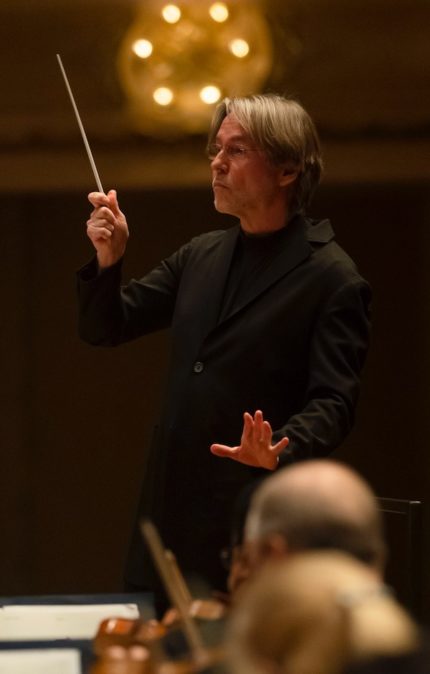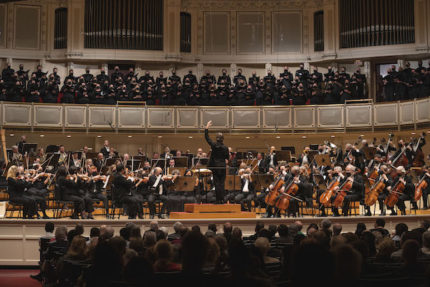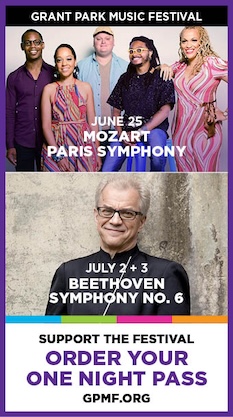Salonen leads CSO in brilliant showpieces by Ravel and Salonen

The second and final week of Esa-Pekka Salonen’s spring residency with the Chicago Symphony Orchestra provided a showcase for both sides of the Finnish musician—as conductor (of course) but also as composer.
Though his music has been less frequently programmed in recent seasons, Chicago audiences have heard several Salonen works performed by the CSO under his baton over the past decade, including his Violin Concerto and Cello Concerto, the latter in a 2017 world premiere with Yo-Yo Ma.
Thursday night brought the local premiere of Salonen’s Gemini. Scored for huge orchestra, Gemini is a hybrid work as the composer-conductor outlined in his eccentric yet engaging introduction.
Salonen heard a “post-grunge” bass line playing in a Paris restaurant and quickly jotted the theme down on a napkin. He became fascinated by this theme and worked it into a motto for his work Pollux. There are other less literal inspirations as well, including a wordless chorale on a Rilke poem and a surreal Dali painting.
As he worked on Pollux, Salonen found the music going in an apposite direction, which would not cohere with his existing plan. The solution was a literal two-headed creation: the extant Pollux and a new section “Castor,” separate but aligned. As in the Greek myth, the two half-brothers are now twined together as Gemini (though either section can still be performed separately as well).
Gemini opens with Pollux painted in a striding theme, powerfully punched out by two sets of timpani against seesawing strings. The character is suggested in the punchy, lumbering main motif (a slowed-down version of Salonen’s ear-worm bass line) while his semi-divinity is reflected in the balm of the contrasting theme for flour flutes (inspired by Rilke’s Sonnets to Orpheus).
The music continues in sweeping, vital fashion, the banked power of Pollux painted with brilliant scoring that sometimes feels like nature painting of Ravel’s Daphnis viewed in a distorted mirror. After a keening oboe solo, the chorale theme rises to a majestic peroration, followed by a nostalgic English horn solo and a quiet coda.
That ending now leads attacca into “Castor,” and here we clearly have the less respectable sibling. As Salonen put it, this is the hyperactive brother, “a bad boy full of tricks.” Lightning restless strings usher in a jumpy agitated quality, punctuated by the two timpanists and a pair of bass drums set against loud brass outbursts. The music rises to increasingly thunderous climaxes and quietens again, soaring to a final coda with massive pounding timpani, the brothers conjoined musically at last.
As shown in his previous works, Salonen is an imaginative and greatly gifted composer, and his best qualities are fully on display in this, his most recent (2018-19) large-scale effort. Salonen works his fanciful conception out in a compelling and engaging fashion in music that has a hard-charging rock edge to it, scored with skill and kaleidoscopic panache for vast resources.
Still, one can’t help feeling that there are one or two crescendoes too many in the latter half of the “Castor” section, and that the 23-minute score would be even more effective if it were five minutes shorter.
Nonetheless, Gemini is a glittering, audaciously scored thrill ride and received an enthusiastic ovation in its Chicago premiere Thursday night with many in the audience standing and cheering. The CSO delivered the goods for Salonen’s music with epic strength and fizzing energy, not least the resounding power duo of timpanists David Herbert and Vadim Karpinos
Another work for large orchestra, Ravel’s complete ballet, Daphnis et Chloe concluded the evening.
Back in the day a PR burb for RCA recordings of classical showpieces invariably promised “A Sonic Spectacular!” Such was truly the case with the CSO’s perfumed performance of Ravel’s complete 1912 ballet Thursday night, which made a remarkable impact even after the flashy brilliance of Salonen’s piece.
From the barely audible rustling of nature in the opening bars, Salonen led a performance with a vast range of hues, dynamics, and expression, the 50-minute ballet unfolding in a seamless narrative arc. The nature-painting of the ballet was evocatively rendered, as with the gauzy haze of the strings in the opening scene, and the limpid wind solos depicting the various nymphs and satyrs.
Yet there was nothing effete or overrefined in this Daphnis and the Salonen-led performance had a spine of steel. The Pirate’s Dance went with crashing brilliance and animalistic vitality. Each episode was given its full due from the brass’s haw-haw laughter at Dorcon’s dorkish dance to the unsettled grace of Chloe’s pleading Dance of Supplication. The performance was rounded off with a decidedly unsafe Bacchanal, orchestra and chorus built to a fever pitch in a blazing coda.

Salonen is as fully in his element with French repertory as he is with contemporary music. He led an organic, atmospheric performance of Ravel’s masterpiece, as alive to the score’s pastoral delicacy as to the frenzied fortissimo climaxes. The orchestra delivered grand and luxuriant playing under Salonen, filling the hall with layered sumptuous sound in a spectacular fashion that happens not often enough.
The CSO acquitted itself superbly across all sections with liquid solo work by oboist William Welter, fluent horn playing from David Cooper and, especially, flutist Stefán Ragnar Höskuldsson’s languid, sinuous representations of Pan.
The CSO Chorus has been sorely under-utilized this season, understandable to some extent due to Covid precautions. Prepared by associate director Cheryl Frazes Hill, the ensemble provided resplendent singing, adding sonorous impact on top of Ravel’s shimmering climaxes. The singers performed bemasked, though in the wordless vocalise of this work with no negative effect on the result.
The evening led off with Entr’acte by Caroline Shaw. Written in 2011 for quartet and arranged for string orchestra three years later, the work was inspired by a performance Shaw heard of a Haydn string quartet (Op. 77, no. 2), the minuet movement in particular.
Entr’acte opens with a galant theme that has a Haydnesque character. That stately, slightly hesitant melody soon becomes harmonically unmoored as Shaw subjects it to a controlled demolition. The center cannot hold and the Rococo theme starts to fall apart with free riffs, spare violin and cellos solos, pizzicatos and aching sighs that verge on unsettling moans. Violins rise higher and softer in a fade and the work ends in unsettled melancholy with a muted cello solo.
Salonen directed Shaw’s work with a fellow composer’s textual focus and attentive detailing. He drew a dauntingly terraced array of dynamics and expressive nuance from the CSO strings, making every free riff, sliding pitch and expressive request (“like a little sigh” ) register. Assistant principal cellist Kenneth Olsen imbued his solo with a hushed and ghostly ars antiche quality.
Esa-Pekka Salonen, unfortunately, is not on the CSO roster for 2022-23, so grab the opportunity to catch this talented and versatile musician this weekend while you have the chance.
The program will be repeated 1:30 p.m. Friday and 8 p.m. Saturday. cso.org
Posted in Performances


Posted Jun 03, 2022 at 8:56 pm by Argyle1
Wind totally out of the sails, with Shaw, Salonen and the CSO. This once-glorious orchestra desperately needs a great conductor who will truly challenge them, with Salonen, as always, completely overrated in any music from before 1930. To those of us who heard them live, under Solti, Boulez, Abbado, Barenboim, et.al., — even Muti, in the early days — the utterly lackadaisical sound of the ensemble has become appalling. Maybe the cumulative effect of COVID, and all those masks, is also a factor, but the rot had set in well before then. We can hope for better days ahead.
Posted Jun 06, 2022 at 6:53 pm by Alan Goldberg
The review was spot on. A glorious program and performance.
I have no idea what the previous commenter is talking about. Did he even attend the concert?